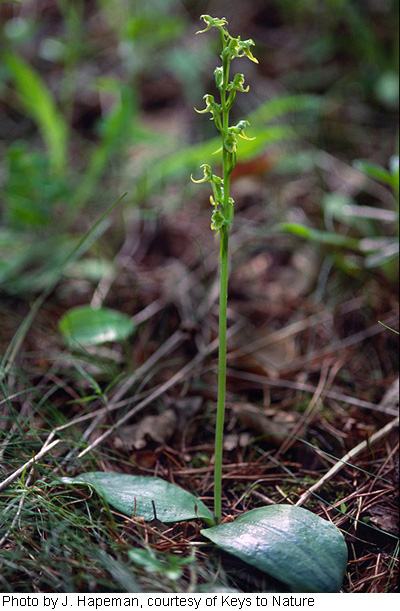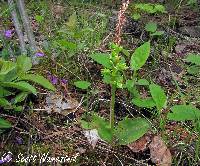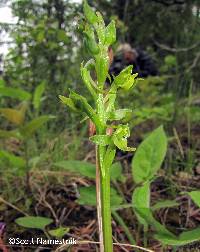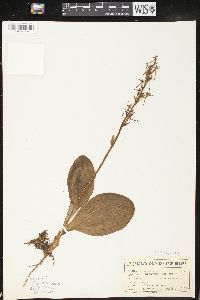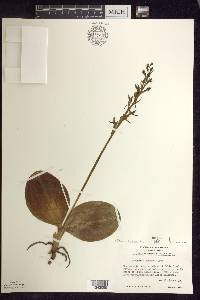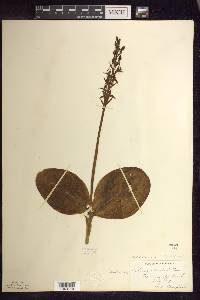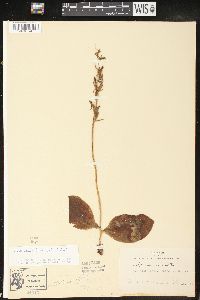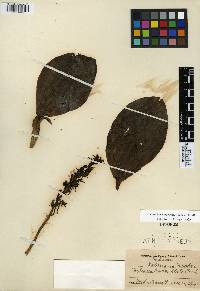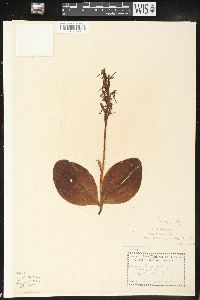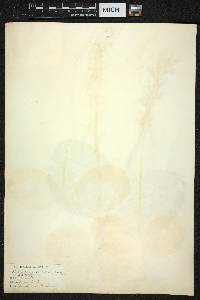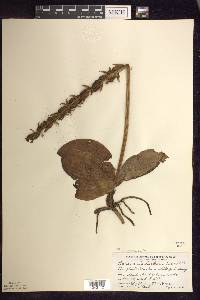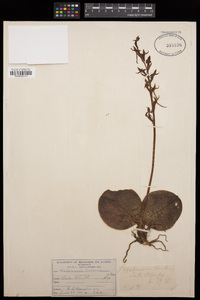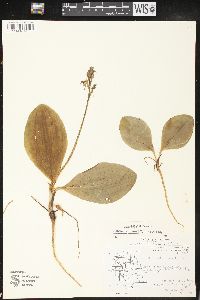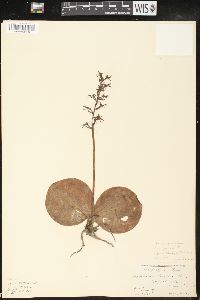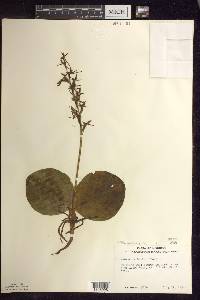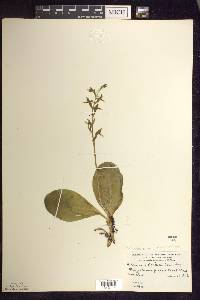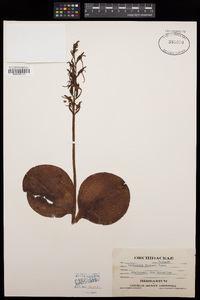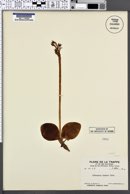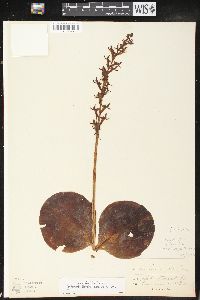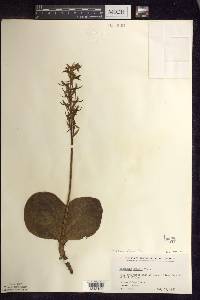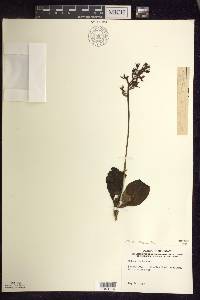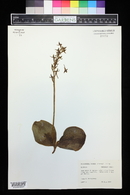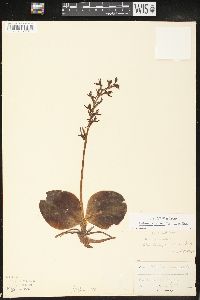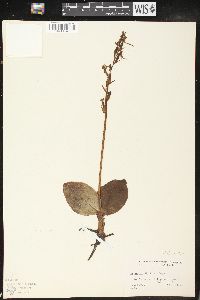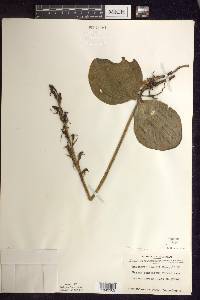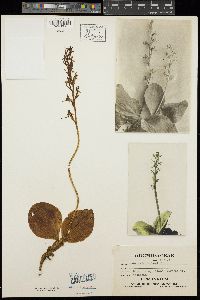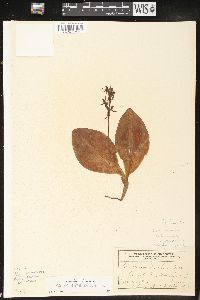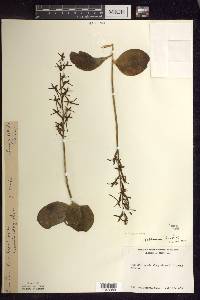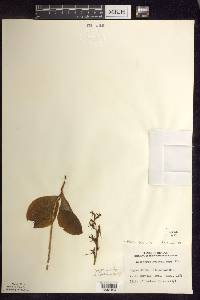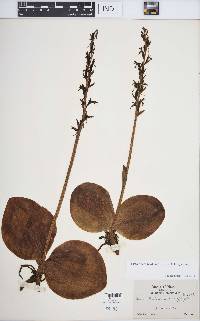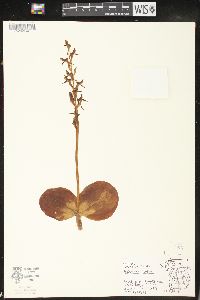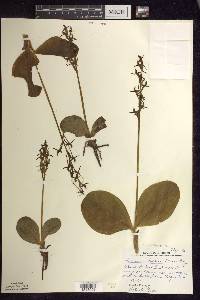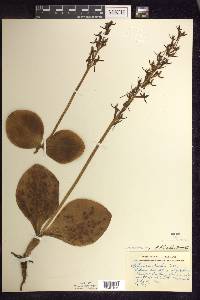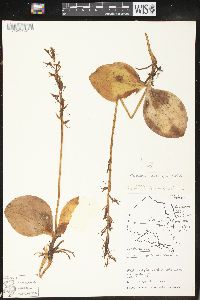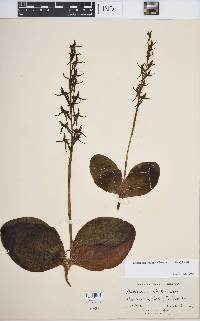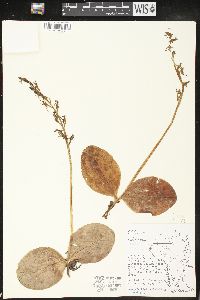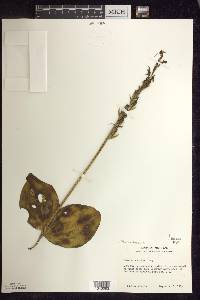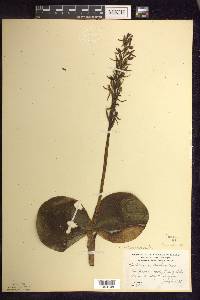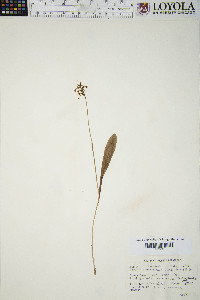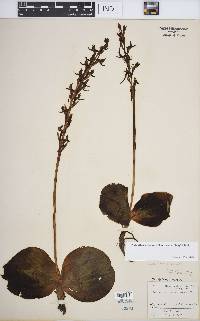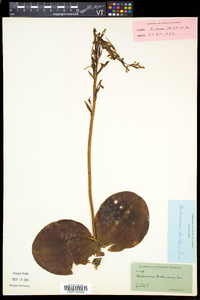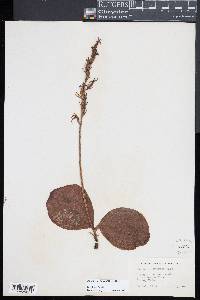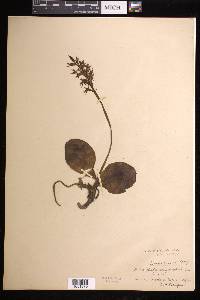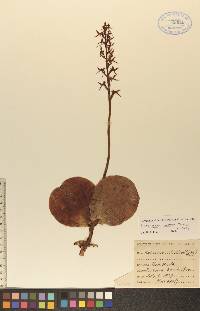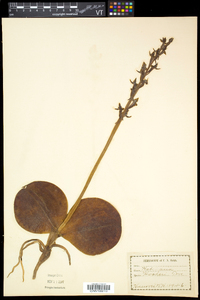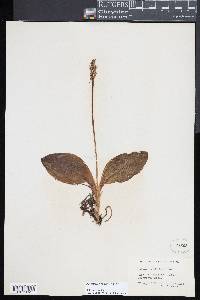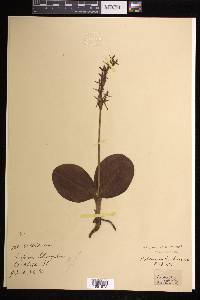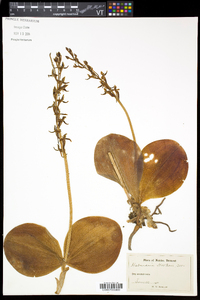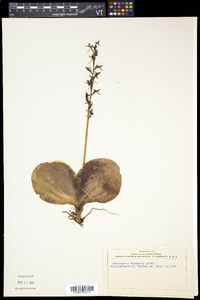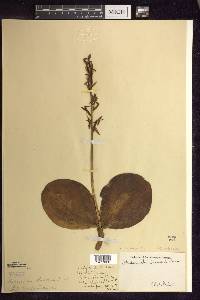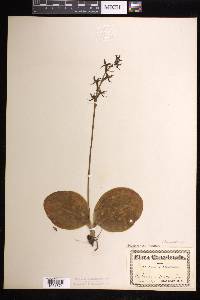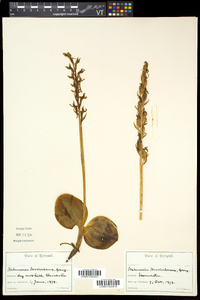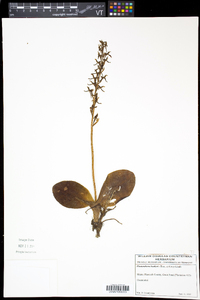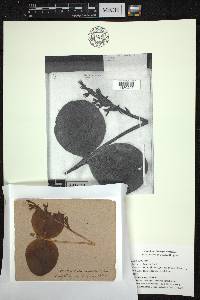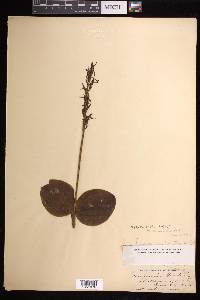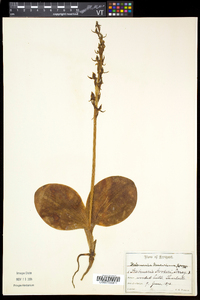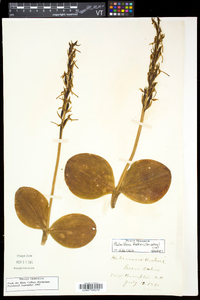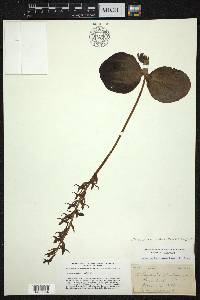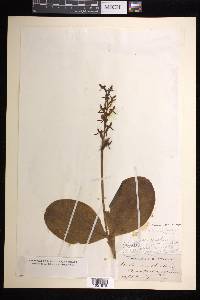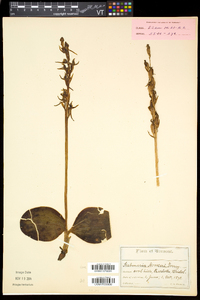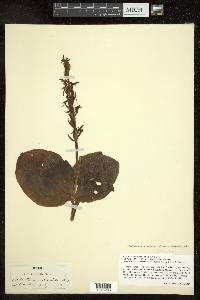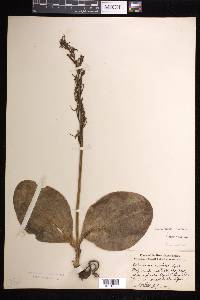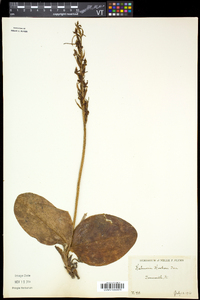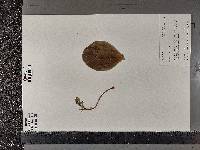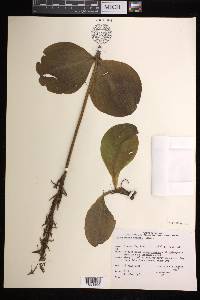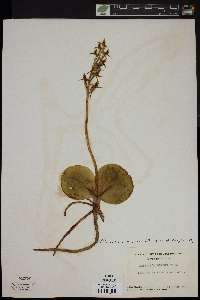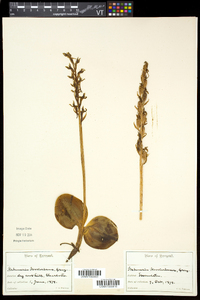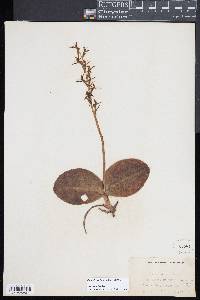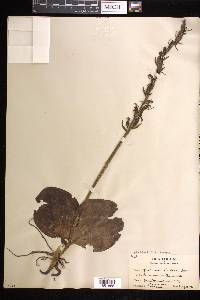Platanthera hookeri
|
|
|
|
Family: Orchidaceae
Hooker's Orchid
[Habenaria hookeri Torr. ex A. Gray, moreHabenaria hookeri var. abbreviata Fernald, Habenaria hookeriana Lindl., Orchis hookeriana (Lindl.) Oakes] |
Plants 18-45 cm. Leaves 2, in subequal basal pair, spreading-ascending or lying on ground; bracts 0(-1, very rarely); blade orbiculate, broadly elliptic, or obovate, 5-17 × 4-13 cm. Spikes lax. Flowers resupinate, not showy; calyx green; corolla commonly yellowish green; lateral sepals reflexed; petals narrowly lanceolate-falcate, margins entire; lip projecting to porrect, lanceolate to narrowly lance-rhombic, without basal thickening, 8-23 × 1-6 mm, margins entire; spur slenderly conic, 11-27 mm; rostellum lobes very wide-spreading, angular; pollinaria nearly straight; pollinia remaining enclosed in anther sacs; viscidia suborbiculate; ovary slender to rather stout, mostly 8-20 mm. 2n = 42. Flowering May--Aug. Dry to mesic coniferous and deciduous forest; mostly 0--500 m; Man., N.B., Nfld. and Labr. (Nfld.), N.S., Ont., P.E.I., Que.; Conn., Ill., Ind., Iowa, Maine, Mass., Mich., Minn., Ohio, Pa., N.H., N.J., N.Y., R.I., Vt., Wis. Perennial herb 18 - 45 cm tall Stem: single, erect, green, hairless, with only two basal leaves, and rarely even one bract near middle of stem. Leaves: two, basal, subopposite, stalkless, spreading-ascending (in flower) or laying flat on ground (but then at least edges ascending), distinctly dull light green, never shiny or glossy, non-toothed, hairless, 5 - 17 cm long, 4 - 15 cm wide, round-circular to broadly elliptic or more inversely egg-shaped. Inflorescence: a single, erect, terminal, hairless, elongate, loose, spike-like cluster of six to fifty stalked flowers with each flower subtended by a short bract. The 1 - 1.5 cm long, about 3 mm wide, lance-shaped, long-tapered, pointed tip, non-toothed, hairless bracts are never longer than the flowers. Flowers: short-stalked, erect, yellowish green, not showy, small, hairless, bilaterally symmetric with reflexed lateral sepals, center sepal and lateral petals closely positioned and pointing forward above the narrow, upward-curved lip petal, which has base modified into a nectar spur. The reproductive parts of stamens, stigma and style are fused into a column above the 0.8 - 2 cm long inferior ovary. Profile view of flower shaped like letter "c", and similar to pair of ice tongs, in front view much like an open-mouthed snake baring its fangs. Sepals: three, green, hairless, non-toothed, with two lance-shaped and tapering pointed-tipped, 0.9 - 1.3 cm long, 3 - 4 mm wide lateral sepals reflexed backwards against ovary. The central, uppermost sepal, which is typically only 0.5 - 1 cm long, 3 - 5 mm wide, and triangular-lance-shaped to egg-shaped is positioned very closely to the lateral petals, together extending forward to form a long hood over the column. Fruit: few, fairly stalkless, erect, ellipsoid, hairless, lengthwise ridged capsules with remnant floral parts at apex, and subtended by short, ascending bracts. Roots: several, fleshy. Lateral petals: two, yellowish green, extended forward and curved downward, flanking central sepal, hairless, non-toothed, 0.5 - 0.9 cm long, 2 mm wide, linear to lance-shaped. The lateral petals and central sepal form a long arching hood over the column and opposite the upward curved lip, which means when the flowers is viewed from the side it resembles the letter "c". Lip petal: one, central, lowermost, forward pointing, curved upward past middle, yellowish green, fleshy, non-toothed, hairless, 0.8 - 2.3 cm long, 1 - 6 mm wide, narrowly triangular to lance-shaped, and long-tapering to pointed, up-curved tip. The base of the lip petal is modified into a backward descending, 1.1 - 2.7 cm long, slenderly cone-shaped spur which tapers evenly downward. Similar species: In our area, Platanthera hookeri is most similar to P. orbiculata, which usually blooms later, and differs morphologically by having several bracts scattered along the stem, the leaves are shiny or glossy and lay flat on the ground, the flowers are more whitish green, and the lateral petals are upward spreading, which when viewed from the front looks like horns spreading outward on the sides of the center sepal above the obviously downward pointed lip petal. The other fringeless-lipped species of Platanthera in our area have obvious stem leaves that reduce gradually in size into bracts above. Flowering: late May to early July Habitat and ecology: Very rare, probably extirpated in many counties, in our area mostly in mixed hardwood forests dominated by American beech and sugar maple, but in its main range north of us, found primarily in dry to mesic coniferous woods. Occurence in the Chicago region: native Notes: This is a much more northern species and the Chicago Region is at the south end of its range. Platanthera hookeri is probably extirpated from Cook and Lake Counties in Illinois, and no longer exists in Indiana where its primary habitat has been destroyed or altered for industrial development (Homoya 1993). The small yellowish green flowers of this two-leaved orchid are very distinctive. From the side, the forward arching hood opposes the long forward pointing and upward curved lip. When viewed from the front, the flower looks like a tiny snake head with mouth wide open, baring fangs, and extending a pointed, upward curled tongue. Etymology: Platanthera comes from the Greek words platys, meaning flat or broad, and anthera, meaning anther, which refers to the wide anther of the genus. Hookeri is named after William J. Hooker (1785-1865), an English botanist. Author: The Field Museum Scape arising from a few fleshy roots, 2-4 dm, bractless; lvs 2, basal, prostrate, 6-12 cm, broadly elliptic to rotund, seldom narrower; fls sessile, yellowish-green, ascending; lip lance-triangular, directed outward, upcurved, 8-12 mm; lateral sep widely reflexed behind the fl, alongside the ovary; lateral pet lanceolate, incurved and ±adjacent to the upper sep; spur 13-25 mm, directed downward, tapering to the tip; 2n=42. Rich moist woods; N.S. and Nf. to N.J. and Pa., w. to Man., Minn., and Io. June, July. (Lysias h.; Platanthera h.) Gleason, Henry A. & Cronquist, Arthur J. 1991. Manual of vascular plants of northeastern United States and adjacent Canada. lxxv + 910 pp. ©The New York Botanical Garden. All rights reserved. Used by permission. From Flora of Indiana (1940) by Charles C. Deam This is also one of our rarest orchids. It has been reported from Lake, La Porte, Noble, and Porter Counties. There is a specimen in the Field Museum which was collected by Agnes Chase, June 21, 1897, east of Edgemoor (probably near what is now known as the Buffington Cement Plant or West Gary). The specimen in the Field Museum so labeled and collected by Bross in La Porte County is Orchis spectabilis. The report from Noble County is not supported by a specimen and I refer the report to Habenaria orbiculata. Dr. Lyon found a few plants in Porter County. It has been found also by R. M. Tryon, Jr., in Dunes State Park, Porter County and he has given me a specimen. …… Indiana Coefficient of Conservatism: C = 10 Wetland Indicator Status: FAC |

